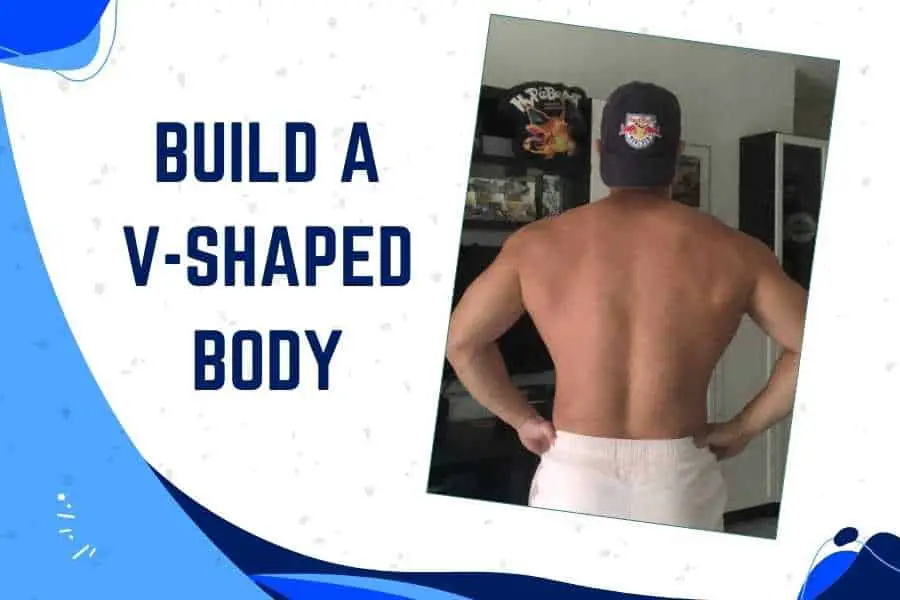The classic V-taper is a body shape that many beginners strive for. It screams athleticism, your tees fit better, and best of all, it gives you a newfound sense of confidence. But the process can also be a long and frustrating journey for beginners. This guide shares 5 simple workouts you can do (with or without weights) to build a defined V-shaped body.
A prominent V-shape is characterized by a broad shoulder and back with a slim waist. This can be achieved through training and dieting. Workouts can be performed with a combination of barbell, dumbbell, band, and/or bodyweight exercises.
As a skinny-fat newbie, I wasted many months of trying to to get in shape without seeing positive results.
Here are some of the mistakes I made:
- Misidentifying the wrong muscles that ACTUALLY give you a pronounced V.
- Not including enough compound exercises like rows, pull-ups, pull-downs, and shoulder presses.
- Performing insufficient sets and reps without even realizing it.
- Undereating calories and protein.
Below, I’ll reveal exactly what I did to eventually achieve the body that I always wanted so you don’t have to go through the same frustrating experience that I went throuh. Be sure to read my ninja tips to help you minimize the risk of failure!

Here are my personal transformation pics from left to right: 1) skinny-fat beginner, 2) V-shape after a 6-month lean bulk, and 3) prominent V-shape after an extended 1-year bulk.
- Muscles That Contribute To A V-Shaped Body
- 5 Workouts To Build A V-Shaped Body
- 1) Barbell Workout
- 2) Dumbbell Workout
- 3) Kettlebell Workout
- 4) Resistance Band Workout
- 5) Bodyweight Workout (No Equipment Required)
- Which Workout Is The Best For Building A V-Shape?
- Nutrition Tips To Build A Prominent V-Shape
- How Long Will It Take To See A V-Shape?
- Ninja Tips To Build The V-Shape Fast
- Conclusion
Muscles That Contribute To A V-Shaped Body
Knowing which muscles to train is key to successfully building a V-shaped body.
The “V-torso” is characterized by a slim waist-to-upper body ratio. In other words, A wide upper body and a narrow waist. This gives the visual impression of an “inward taper” when viewed from top to bottom.
Here are the most important target muscles you need to focus on to achieve this:
| Muscle | Why It Contributes To The V-Shape |
|---|---|
| Latissimus Dorsi | Gives the mid-torso an outward flare from the waist to the armpits.* |
| Rhomboids | Adds mass to the mid-back. |
| Trapezius | Adds mass to the upper-back. |
| Anterior Deltoids | Increases front shoulder definition (essential!).* |
| Lateral Deltoids | Broadens the side shoulder. |
| Posterior Deltoids | Contributes to a balanced V-tapered back.* |
* key muscles to achieving a defined V-shape.
1) Latissimus Dorsi
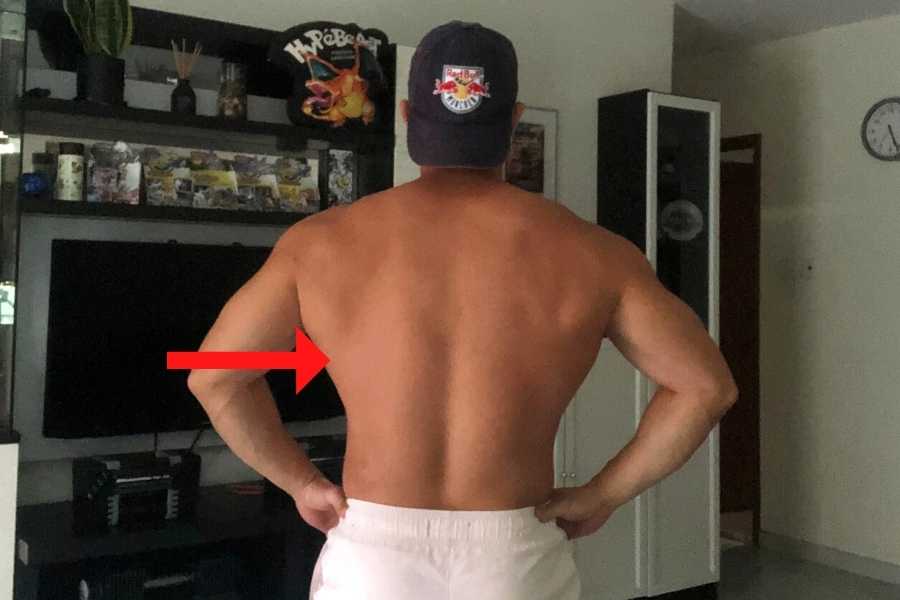
The latissimus dorsi is a large pair of back muscles inserted just below the armpits and at the waist. The more you develop your lats the more prominent your V-shaped body will be.
This makes it one of the most important muscles to train.
Exercises that bring your elbows towards the mid-back in a downward motion will effectively engage your lats. Examples include:
- Pull-ups.
- Chin-ups.
- Barbell and dumbbell rows.
- Pull-downs.
2) Rhomboids
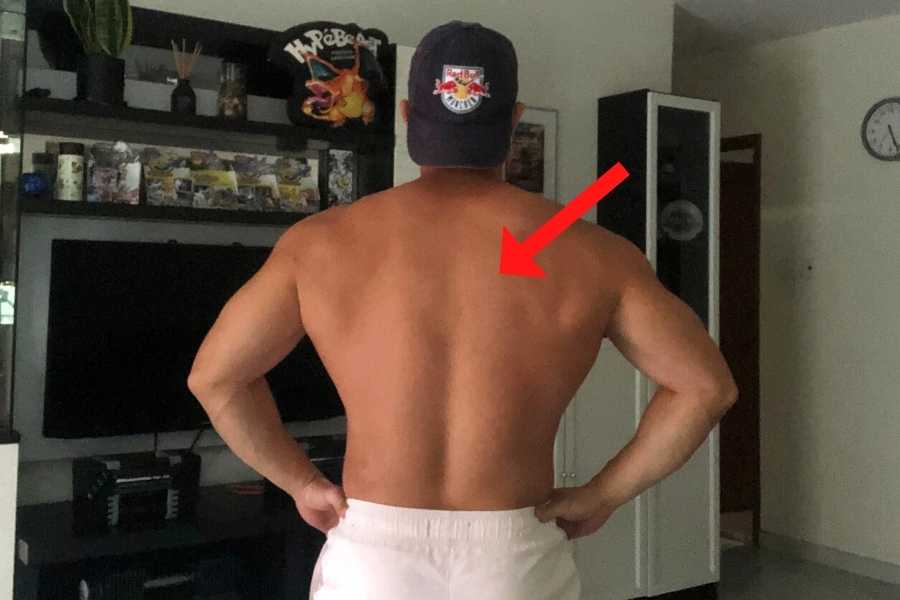
The rhomboids are a small group of muscles found at the center of your mid-back. Whilst they aren’t essential for building a prominent V-shape, they do add overall volume and balance to your upper body.
They also stabilize (thereby strengthening) the traps and lats. And this can indirectly help you to perform rows and pull-ups more effectively.
You can hit your rhomboids with movements that retract the shoulder blades backward. Examples include:
- Reverse flyes.
- All variations of pulling and rowing movements.
3) Trapezius
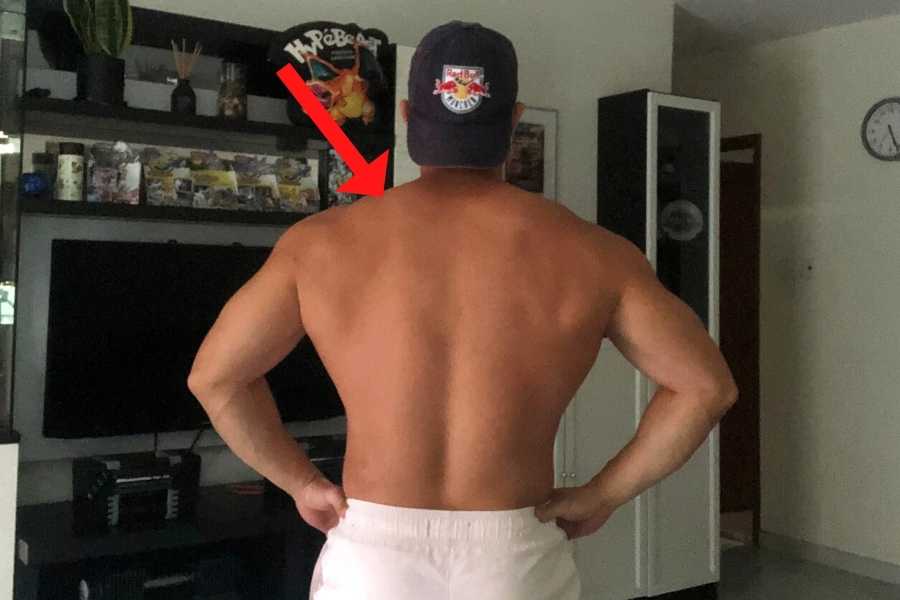
The trapezius muscles are nestled between the shoulders just underneath the back of your neck.
Just like the rhomboid, the traps won’t make or break your efforts to build a V-tapered flare. But they will contribute to an overall thicker, stronger, and more balanced “Dorito-like” back.
This makes it important to not neglect this muscle.
Movements that bring your shoulders upwards and backward will hit your traps. Examples include:
- Vertical/upright rows.
- Deadlifts.
- Shrugs.
4) Anterior Deltoids
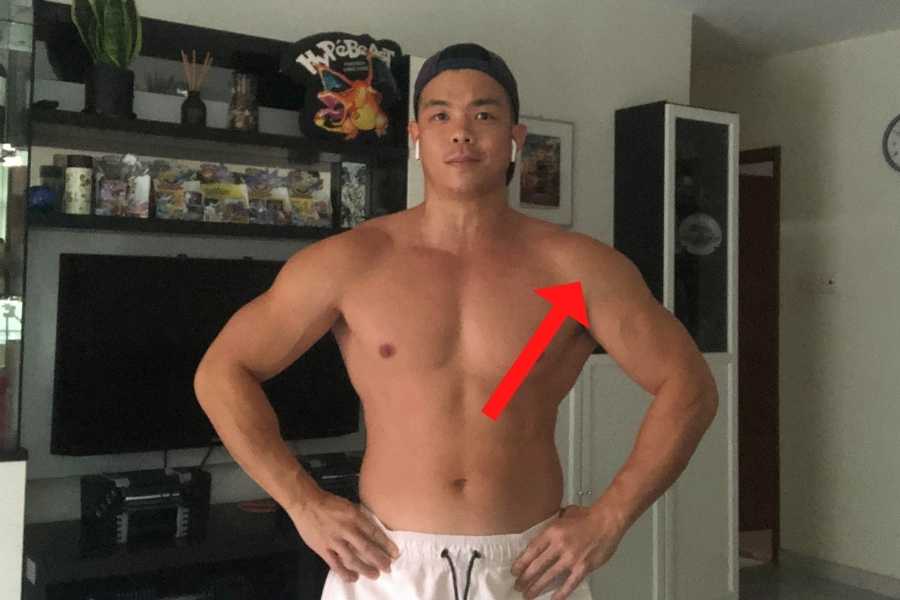
Your shoulders comprise 3 main deltoid muscles– anterior (front), lateral (side), and posterior (back).
Although the anterior delts sit in the frontal plane, they still contribute to a strong “3D” V-shape by adding overall mass to your shoulders. A strong pair of anterior delts can also help broaden your chest to complement the V-taper.
Exercises that bring the arms forward in an upward motion will effectively train the anterior delts. Examples include:
- Shoulder press variations.
- Incline bench press.
- Front raises.
- Pike push-ups.
5) Lateral Deltoids
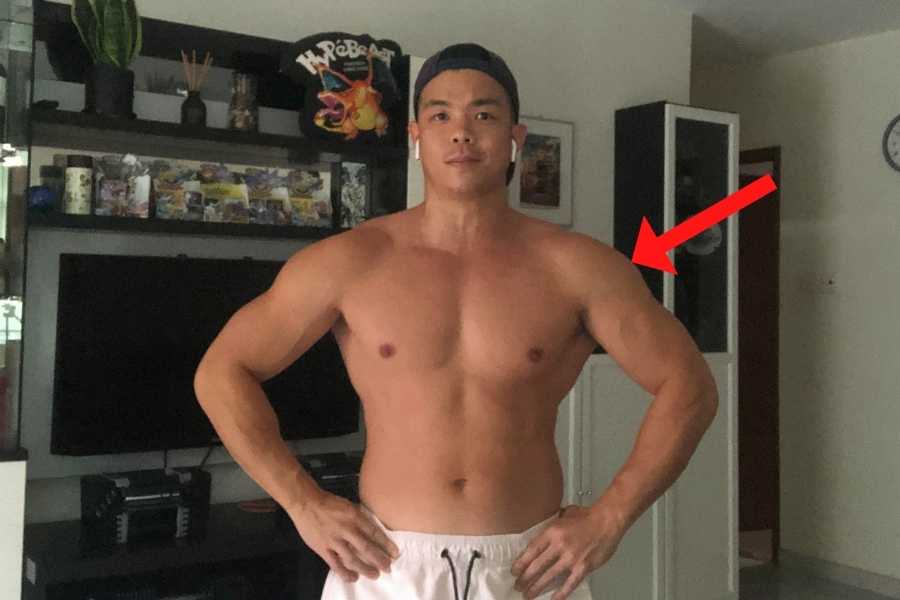
The lateral (side) deltoids sit on the side of your shoulders.
Developing strong anterior and lateral delts is key to increasing shoulder size and broadening your upper body. And together with the lats, the delts are probably the most important muscles for carving a strong V-shaped physique.
Effective movements to work your lateral delts will raise your arms upwards and outwards away from your torso midline. Good examples include:
- Shoulder press variations.
- Lateral raises.
- Upright rows.
6) Posterior Deltoids

In my opinion, the posterior (rear) delts are the unsung heroes of the V-tapered back.
They’re a relatively small muscle that beginners often neglect. But training these unassuming muscles will complete your V-taper by broadening your upper torso.
Exercises that bring your arms backward and upwards are the best way to engage these muscles. My favorite examples include:
- Incline rows.
- Rear delt flyes.
- Shoulder pressing.
- Deadlifts.
5 Workouts To Build A V-Shaped Body
In the previous section, I detailed the individual muscles you need to train in order to carve a strong V-tapered physique. Now I’ll share 5 workouts you can do to effectively hit those muscles.
Each workout focuses on a different type of equipment in order to cater to all needs:
- Barbells.
- Dumbbells.
- Kettlebells.
- Resistance bands.
- Bodyweight calisthenics (no weights required).
Simply choose one that’s most suitable to the type of equipment you have available. You can even combine exercises from different workouts because many of them are variations of the same core movement.
The important thing is that each workout will hit all the key muscles listed previously.
Each workout should take no longer than 60 mins to complete.
1) Barbell Workout
The barbell is a great way to get a V-tapered body due to its:
- Sheer versatility- all muscles can be trained with a barbell.
- Suitability for compound movements- these are exercises that engage multiple muscle groups at once for fast progress.
- Near-unlimited options to increase weight load- this is important for growing your back and shoulders quickly.
However, most people will need a gym membership to take full advantage of this barbell workout.
Here’s the workout:
| Barbell Exercise | Reps | Sets | Weight | Muscles Worked |
|---|---|---|---|---|
| Neutral-Grip Bent-Over Row | 10 | 4 | 75% 1RM | Lats, traps, rhomboids, and arms |
| Seated Shoulder Press | 8 | 4 | 80% 1RM | Deltoids and arms |
| Conventional Deadlift | 5 | 4 | 90% 1RM | Lats, traps, rhomboids, deltoids, and legs |
| Flat Barbell Bench Press | 8 | 4 | 80% 1RM | Chest, deltoids, and arms |
1RM = 1 Rep Max
Beginners can start by repeating each workout 3 days per week with at least 24 hours (1 day) of rest between each workout. This means you’ll hit each of the key V-shape muscles with 12 total weekly sets which are optimal for muscle growth.
Work on completing the allotted sets and reps for one exercise before moving on to the next.
Take a 1-3 minute rest in between sets.
Additionally, you should aim to increase your barbell weight by 5-10% each week (or whenever you feel ready to do so). This is called progressive overload and it will help you build a bigger shoulder and back, fast.
How To Perform These Exercises
A) Neutral-Grip Bent-Over Barbell Row
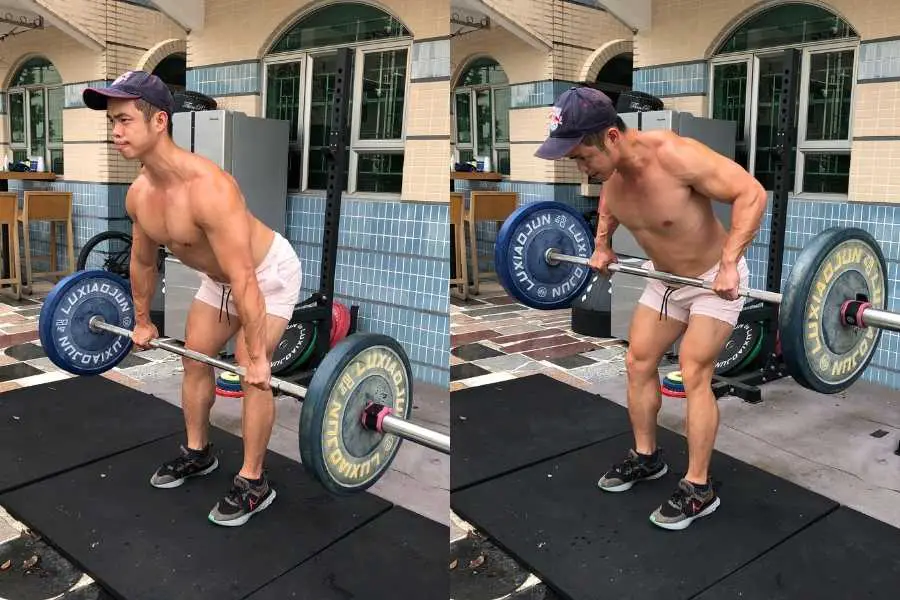
The barbell row is awesome as a general back-builder. Use a neutral (hands shoulder-width apart) overhand grip to maximize lats engagement. Pull the barbell towards your navel and focus on squeezing your shoulder blades together at the same time.
If possible, substitute the barbell row for a lat pulldown or pull-up. The latter two exercises are better for isolating the lats. However, they require a pulldown machine or pull-up bar, respectively. I chose the row as the main back exercise in this workout since this is strictly a “barbell” program.
B) Seated Barbell Shoulder Press

This is one of the best exercises in your arsenal to build bigger and broader shoulders. Most people can press more weight whilst seated vs standing. And this can help to explode your deltoids.
The same movement can also be performed with a machine, dumbbells, bands, and even body weight (see pike push-ups later in the article).
C) Conventional Barbell Deadlift
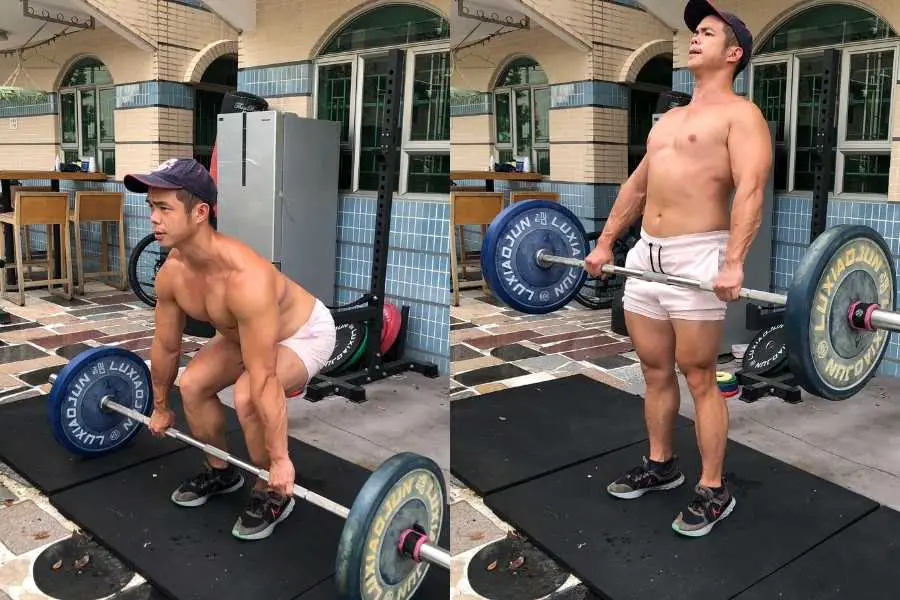
Deadlifting is a powerful and efficient way to work all of the muscles in your body. This includes your lats (to lift the barbell off the ground), traps and rhomboids (to complete the top lockout), and your delts (to stabilize the bar).
I recommend pulling conventional (as shown) rather than “sumo” to maximize posterior-chain activation and overall back development.
D) Flat Barbell Bench Press
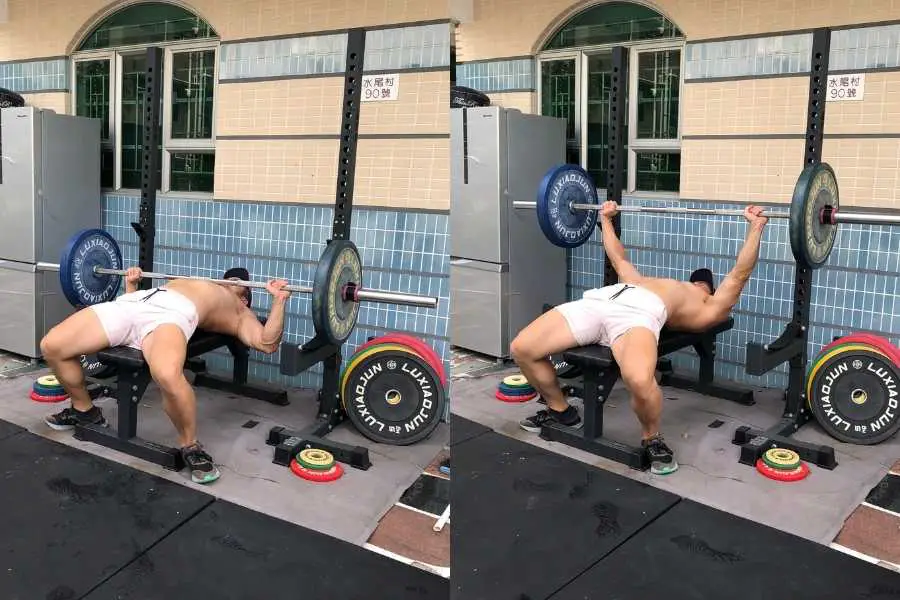
I added the bench press to develop your chest alongside your back and shoulders. This helps prevent an unbalanced physique. Plus, there are few people who would complain about getting bigger pecs!
Furthermore, the bench press also works your anterior delts to help broaden the shoulders.
2) Dumbbell Workout
Dumbbell workouts are my preferred method for building a V-shaped body because they:
- Are cheap and easily accessible- most gyms have a dumbbell rack and adjustable dumbbells are also affordable if you’re looking to build a V-body at home.
- Extremely versatile- unlike barbells, dumbbells can be used for all compound and isolation movements to define specific back and shoulder muscles.
- Have a heavy weight load- both gym and home dumbbells usually go up to 90lbs (45kg) and more. This is more than sufficient for most beginners to achieve a full V-taper transformation.
In my opinion, the only major downside to using dumbbells to build muscle is that they don’t offer as much weight as a barbell can. This can be troublesome when training the lower body. But hey, this article is about building the V-torso, not the legs!
Here’s the workout:
| Dumbbell Exercise | Reps | Sets | Weight | Muscles Worked |
|---|---|---|---|---|
| One-Arm Dumbbell Row | 8 | 4 | 80% 1RM | Lats, traps, rhomboids, and arms |
| Seated Shoulder Press | 8 | 4 | 80% 1RM | Deltoids and arms. |
| Lateral Raise | 10 | 2 | 75% 1RM | Deltoids |
| Dumbbell Pull-Over | 10 | 2 | 75% 1RM | Lats |
| Shrugs | 12 | 2 | 70% 1RM | Traps |
Just like with the previous barbell workout, beginners should repeat this workout as part of a 3-day training split and make sure to rest for at least 24 hours in between each training day.
Here, you’ll hit each V-shape muscle with 18 total weekly sets. This is more than the previous barbell workout but still conducive for optimal muscle gains (20 total weekly sets per muscle are generally considered to be the maximum recommendation for muscular hypertrophy).
As always, work on completing the sets and reps for each exercise, taking a 1-3 minute rest between sets, and increasing weight each week when possible (aka progressive overload).
How To Perform These Exercises
A) One-Arm Dumbbell Row

I chose to include the one-arm row in this workout rather than the conventional two-handed row.
Why?
The former allows more weight to be lifted per hand due to the added stability that comes from placing the non-lifting hand on the bench. Additionally, the extra stabilization also benefits in shifting emphasis directly onto the lats.
And as we all know, the lats are essential for broadening the back!
B) Seated Dumbbell Shoulder Press
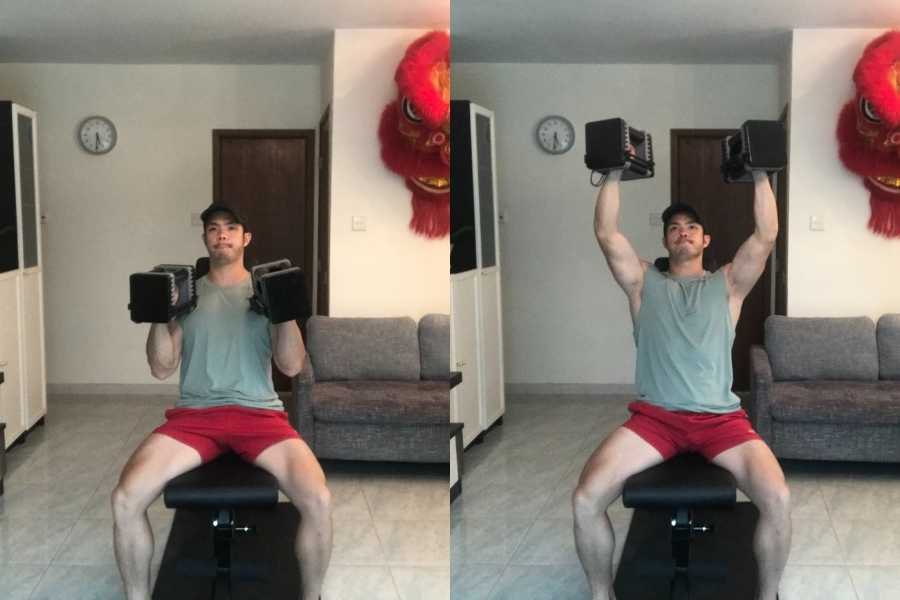
This is the dumbbell variation of the compound barbell shoulder press.
Beginners often have an easier time shoulder pressing dumbbells compared to barbells, making it a great addition to this dumbbell V-shaped body workout.
Make sure you lift with a full range of motion by letting the dumbbells reach the neckline before pressing them back up.
This way, you’ll ensure maximum delt activation to blow up those shoulders!
C) Lateral Raise With Dumbbells
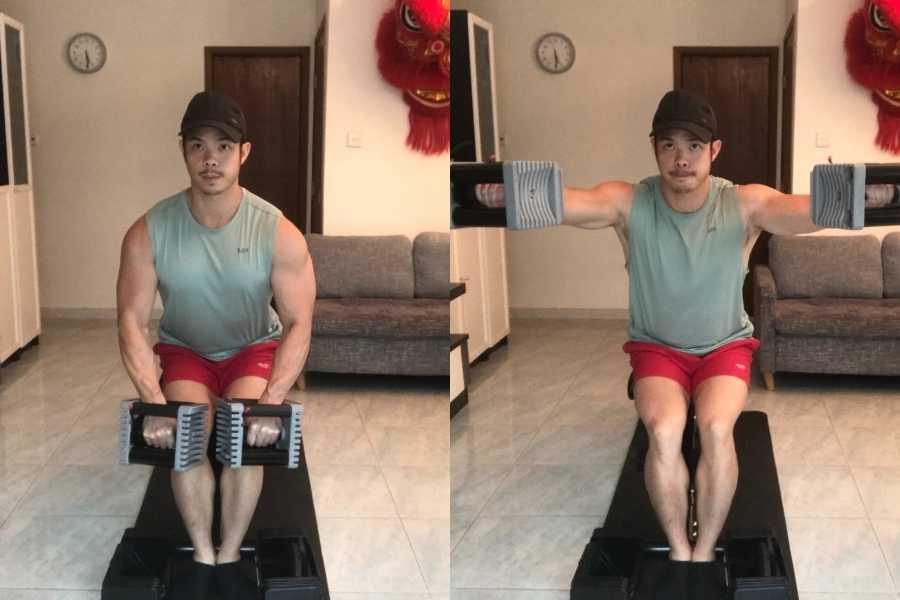
Lateral raises are one of the most effective movements to isolate your deltoids.
I’ve only included 2 sets in this workout. The idea is to use the shoulder press to fatigue your delts before finishing them with the dumbbell raises at the end of your workout.
I found this to be an extremely effective method to promote shoulder growth.
D) Dumbbell Pullover
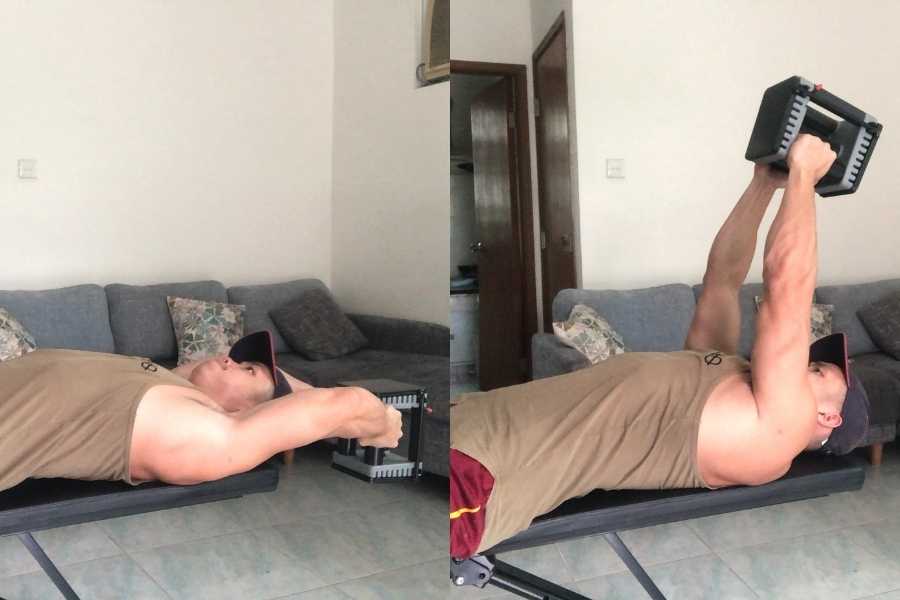
Pullovers are a great substitute for cable straight-arm lat pulldown machines found at the gym (which is a common isolation-type movement to engage the lats).
This exercise can therefore be used to effectively isolate the lats at home.
As with the above-mentioned lateral raises, I like to use this movement as a “finisher”. In other words, do 2 sets of lat raises after completing 4 sets of rows. This will really fatigue your lats.
E) Dumbbell Shrugs
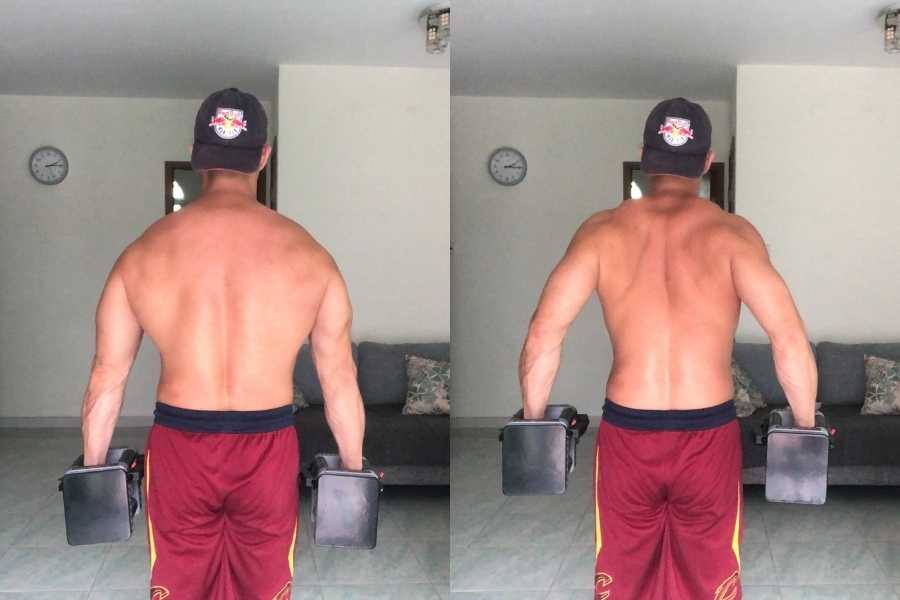
Unlike the previous barbell workout, this dumbbell workout lacks the deadlift.
In my opinion, most people outgrow their dumbbells on the deadlift since it’s such a powerful exercise, and dumbbell weight is usually limited.
Therefore it’s better to work the deadlift muscles individually.
Dumbbell shrugs are an effective finisher for your traps. And this complements the pullover (which hits your lats) to increase mass in your back muscles.
3) Kettlebell Workout
Whilst kettlebells may not be as popular as dumbbells or barbells, they are an effective way to build a V-torso.
Indeed, most of the shoulder and back exercises mentioned thus far can be replicated with kettlebells.
Additionally, they are often used in explosive full-body movements like the snatch. These are great for building your back and shoulders, as well as for burning calories to slim your waist.
However, due to their unconventional shape, the most effective way to use kettlebells is slightly different compared to the other free weights.
Here’s an example workout:
| Kettlebell Exercise | Reps | Sets | Weight | Muscles Worked |
|---|---|---|---|---|
| Clean & Press | 8 | 3 | 80% 1RM | Whole body with emphasis on the deltoids |
| Renegade Rows | 16 | 3 | 70% 1RM | Lats, traps, rhomboids |
| Kettlebell Pullover | 30 secs AMRAP | 2 | 50% 1RM | Lats |
| Side Raise | 30 secs AMRAP | 2 | 50% 1RM | Deltoids. |
1RM = 1 rep max. AMRAP = as many reps as possible in the allotted time.
This is a 3-day split. As always, ensure you rest for at least 24 hours before the next workout. This program hits your lats and delts with 15 total weekly sets which are great for stimulating hypertrophy in the target muscles.
Complete the allotted sets of clean & press and renegade rows to fatigue your back and shoulders before finishing with the pullover and side raise.
Take a 1-3 minute rest in between sets. The shorter the rest period, the greater the cardiovascular demand, and the more calories you’ll burn for a slimmer waist and more prominent V-shape.
How To Perform These Exercises
A) Kettlebell Clean & Press
The clean & press is a two-phase movement that’s great for building a V-torso.
“Cleaning” refers to the first phase where you bring the kettlebell from the ground to your shoulders in one swift motion. This is a full-body explosive movement with an emphasis on back muscle activation. It’s a great way for burning calories and revealing a prominent V-flared upper body.
“Pressing” refers to the second phase where you push the kettlebell upwards. This engages your delts and will help to broaden your shoulders.
B) Renegade Rows
This exercise predominantly works your back. You also get an added calorie-burning benefit by using your non-lifting arm to isometrically support your body weight as you lift the kettlebell.
Renegade rows can only be performed one arm at a time, hence the 16 reps (8 reps per arm). I like to alternate the rows (left then right) rather than completing 8 consecutive reps on one arm before moving to the other arm. This prevents muscle imbalances.
All in all, the renegade row will help you to build a defined V-shape through fat loss and back muscle gains.
C) Pullover With Kettlebells
Pullovers are a good movement to engage your lats without a pull-down cable machine. And the pullover isn’t restricted to just dumbbells. They can also be done with kettlebells too.
I recommend doing this for AMRAP (as many reps as possible) after fatiguing your lats with renegade rows (complete all sets of rows first).
Make sure you let the kettlebell drop as far down as comfortably possible to ensure maximum lats engagement.
D) Side Raise With Kettlebells
This is the kettlebell variation of the dumbbell lateral raise.
It can be performed to finish your delts after they’ve been worked with the clean & press.
Side raises are one of the best exercises you can do to isolate the deltoid muscles and build broader shoulders.
4) Resistance Band Workout
Bands can be a great way for beginners to start building a V-shaped body because they are:
- Extremely cheap- which makes them ideal for newbies to begin training at home.
- Can be used to replicate free weights and cable machines- a good set of bands will come with a door anchor that allows you to work your muscles using different angles. All dumbbell and barbell exercises can be replicated using bands.
- Safe for beginners to use- don’t stretch them past their recommended limit and they are one of the safest ways for a beginner to train.
One thing you need to be cautious about using bands is their weight categorization. It’s not standardized like a 10lb dumbbell or 45lb barbell plate is. Instead, the amount of tension offered by each band is proportional to how much it gets stretched.
I’ve given you general beginner starting weight recommendations (see below) based on stretching the band to 1.5-2x their resting length.
Your target muscles should feel fatigued by the last few reps of each set. If you find the weight too easy, then move on to a heavier band and vice versa.
Here’s the workout:
| Band Exercise | Reps | Sets | Starting Band Weight | Muscles Worked |
|---|---|---|---|---|
| Bent-over row | 8 | 4 | Light-medium | Lats, traps, rhomboids, and arms |
| Standing overhead shoulder press | 8 | 4 | Light-medium | Deltoids and arms |
| Banded Deadlift | 6 | 3 | Heavy | Lats, traps, rhomboids, deltoids, and legs |
| Straight Arm Lat Pulldown | 12 | 2 | Light | Lats |
| Standing Lateral Raise | 12 | 2 | Extra Light | Delts |
As per the other V-shaped body workouts detailed previously in this post:
- Repeat the workout for 3 days a week and rest for at least 1 full day before training again.
- Complete the allotted reps and sets for each exercise (in order) before moving on to the next.
- Rest for 1-3 minutes between sets.
- Apply progressive overload by increasing band weight over time to promote back and shoulder development.
How To Perform These Exercises
A) Bent-Over Row With Bands
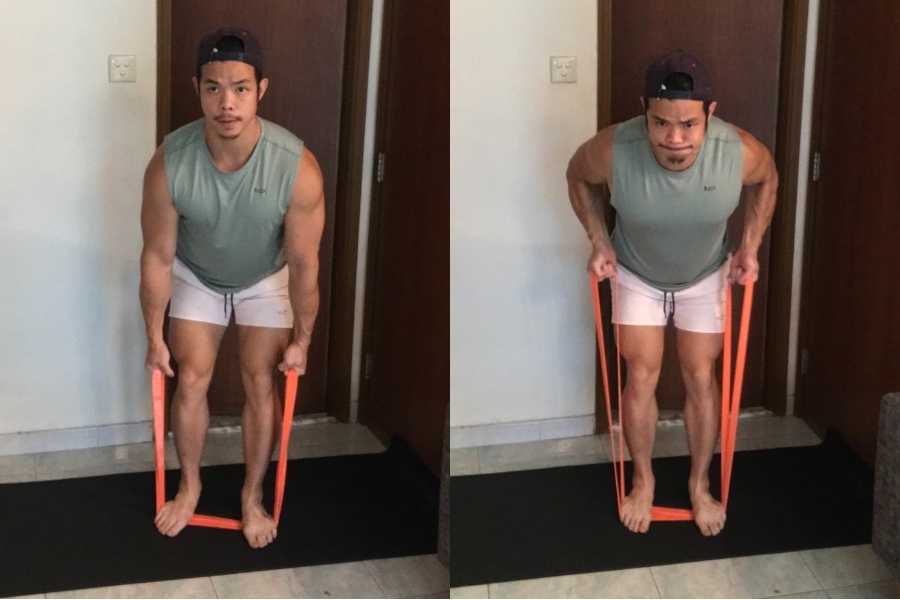
The resistance band variation of the barbell bent-over row; this compound movement is great for fatiguing your lats before hitting them with an isolation-type movement like the straight arm pulldown (see below).
Use an overhand shoulder-width grip.
Focus on stretching the band by bringing your shoulders together rather than pulling using your arms-only. This can maximize the activation of your back muscles, which is what you want for building a V-taper!
B) Standing Overhead Band Press

Shoulder pressing is highly effective for all-around shoulder development. And the banded shoulder press is no exception.
Most people find it more convenient to do the standing variation over the seated one.
Standing allows you to step onto the band, use your body weight to keep it anchored to the floor, and get a really good stretch for maximal band tension.
C) Deadlift With Bands
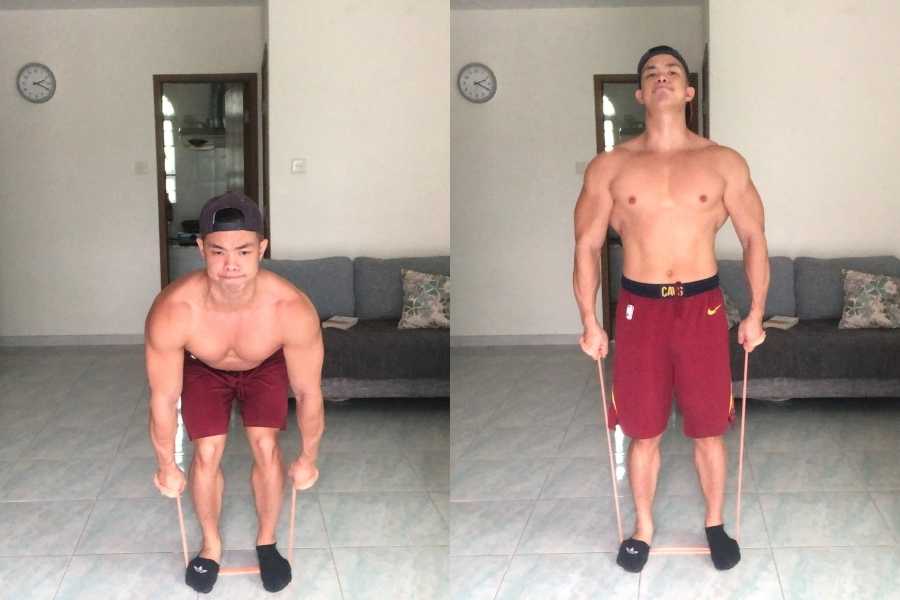
The full-body deadlift can be easily performed using bands to hit your back muscles.
The bottom phase engages your lats as you begin pulling the bands upwards. The top phase engages your traps as you “lock out” (pull your shoulders back and pop your chest out for maximal contraction).
It’s important to make sure the band remains taught at all times to get the full benefits from this movement. Even at the bottom of the deadlift, the band should be under tension (not slack).
D) Straight Arm Banded Lat Pull Down
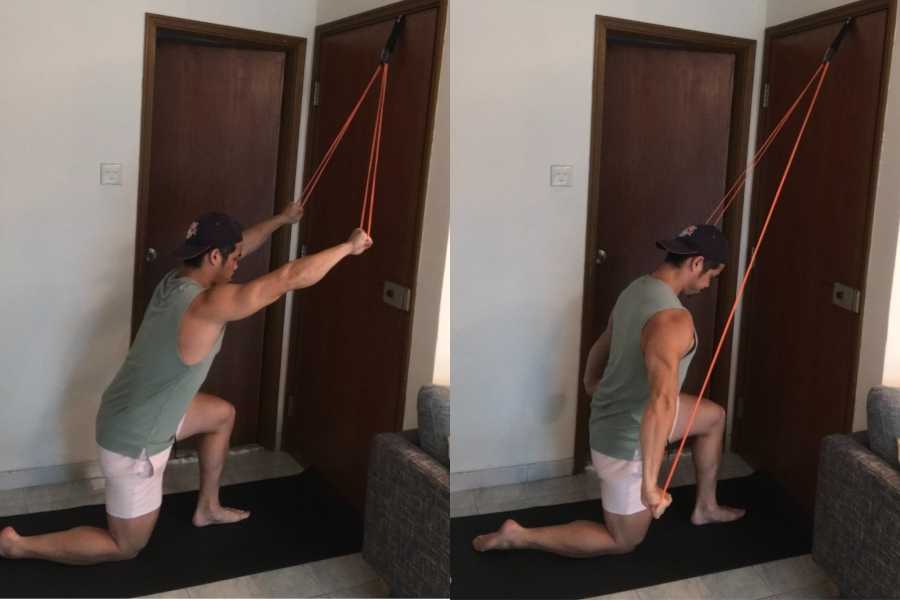
As I mentioned previously, the straight-arm cable pulldown machine is fantastic for isolating your lats and building a V-shaped body. And the movement is easily replicated using bands and a door anchor.
Distance yourself far away enough from the anchor point such that the band is under tension throughout the range of movement.
Keep your arm straight and pull down towards the buttocks.
E) Standing Banded Lateral Raise
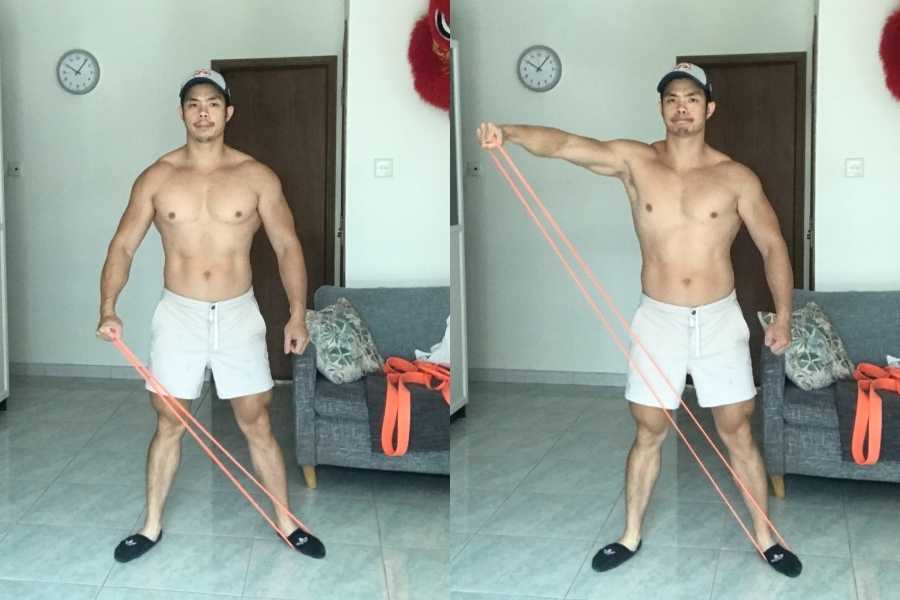
This is the banded equivalent of the dumbbell lateral raise. Perform this exercise at the end of your workout to exhaust your deltoids and build bigger shoulders!
As always, keep the band anchored at a distance that allows for it to be under tension throughout the exercise. This ensures maximal delt activation throughout the range of motion.
5) Bodyweight Workout (No Equipment Required)
I always recommend using equipment to get the fastest results. Using weights and bands allows you to train your muscles harder and more effectively to promote growth in the target muscles.
With that being said, calisthenics workouts can be used effectively to build a V-shape. And there are indeed advantages of bodyweight workouts:
- Free to perform- you are literally lifting your own body weight against gravity. This makes it a great way to train at home.
- Convenient for people without equipment or gym membership- bodyweight workouts do not require any additional equipment and they can be performed just about anywhere you like.
- Effective for untrained beginners- as a newbie, you can build a substantial amount of muscle (and burn fat) with bodyweight movements as long as you fatigue the target muscles.
Here’s an example workout:
| Bodyweight Exercise | Reps | Sets | Muscles Worked |
|---|---|---|---|
| Pull-Up (assisted or unassisted) | 6 | 5 | Lats, traps, rhomboids, and arms |
| Pike Push Up | 8 | 5 | Deltoids and arms |
| Decline Push Up | 8 | 5 | Deltoids and arms |
| Plank | 1x 20-sec hold | 5 | Full-body |
The recommended reps are just that; recommendations.
It’s important to make sure each set is performed within 1-3 reps of muscular failure (the point where you can’t physically do another rep). This will offset the inherent issue of limited weight load present with bodyweight movements.
So, if for example, you find 6 reps too easy, then increase the reps accordingly (and vice versa).
As always- repeat the same workout as part of a 3-day training split and rest for a full day in between workouts. Increase to 4-days when you are ready. Take a 1-2 minute rest in between sets.
How To Perform These Exercises
A) Pull-ups
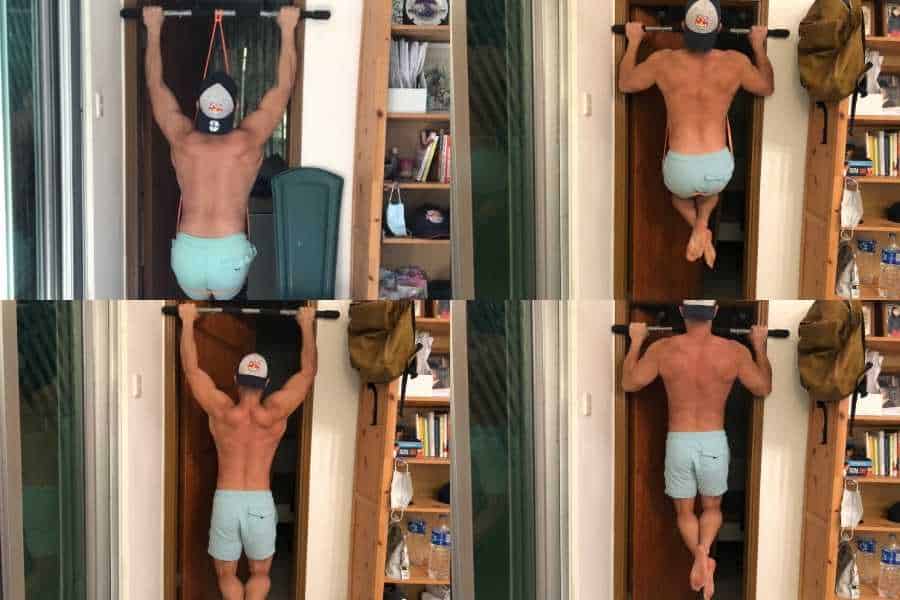
I know the pull-up requires a bar and this is supposed to be an equipment-free workout, but hear me out.
The pull-up is singlehandedly THE best exercise you can do to build a V-shaped body without weights. This vertical pulling movement engages all of the muscles in your back much like a lat pulldown machine. And if you use a shoulder-width grip, it’s particularly effective for isolating the lats.
Most beginners struggle with unassisted pull-ups. In this case, you may find band-assisted pull-ups to be a better alternative. Work on achieving 6 perfect reps with a full range of motion before incrementally reducing band size over time. When you’re ready, you can remove the bands altogether and work on increasing unassisted pull-up reps.
There are also gimmicky home back exercises you can do without a pull-up bar. These often utilize furniture as makeshift bars. But speaking from personal experience, they tend to require a strong grip strength and this detracts from activitng your primary target muscles; the back. They can also be dangerous.
I prefer to invest in a cheap pull-up bar.
B) Pike Push Up
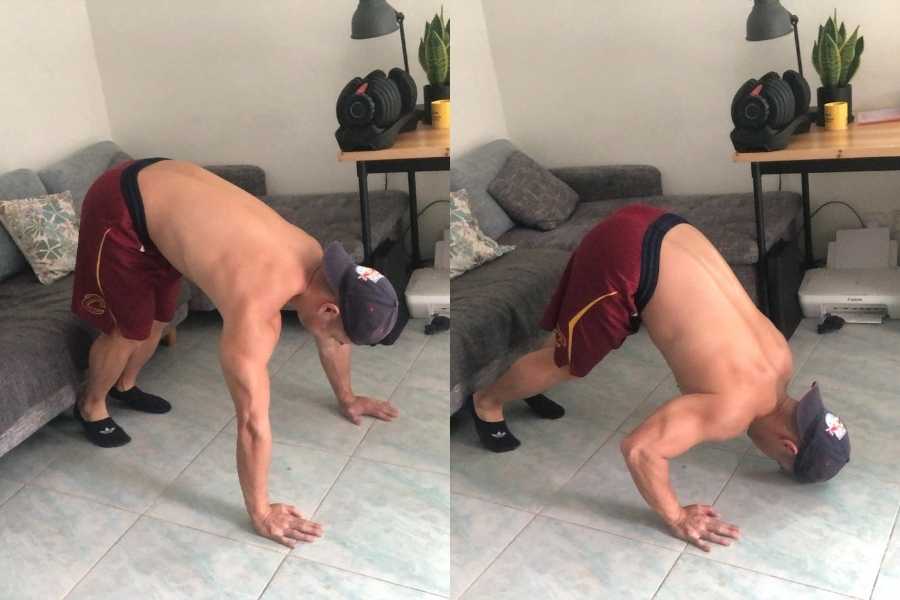
The decline angle in this variation of the traditional push-up shifts emphasis from the chest onto the shoulders. The steeper the decline the more you will engage your delts.
You can also prop your feet on the sofa (like the decline push-up below) for a greater range of motion. This will increase delt activation.
Pike pushups can also be substituted for handstand pushups. The latter is one of the best shoulder exercises you can do at home without weights. But it’s a very technical movement. So be careful!
C) Decline Push Up

Another push-up variation; the downward angle is great for isolating your anterior (front) delts to broaden your shoulders.
As a bonus, you’ll also work the upper chest muscles that sit between your shoulders. And this will contribute to a balanced V-shaped upper body.
D) Bodyweight Plank

This full-body exercise helps burn calories for a slim waist as well as build your shoulders as they engage in an isometric hold.
Clench your buttocks to help you keep a straight back from the torso to the legs.
Additionally, you can plant your arms further apart to shift emphasis onto the delts.
Try to hold this position for 30 seconds at a time. If this is too easy then increase it by 10 seconds (and vice versa).
Which Workout Is The Best For Building A V-Shape?
Beginners can build a V-shaped body with or without equipment. Whilst success can be achieved through bodyweight workouts-only, the extra resistance provided by free weights and bands can benefit faster results. Thus, a decision should be made based on personal preference.
I’ve already shared some of the pros and cons of each training method.
Here’s a recap:
| Training Method | Main Advantage | Main Disadvantage |
|---|---|---|
| Barbell | Allows for heavy lifting which benefits progressive overload and rapid back and shoulder growth. | Most people require a gym membership to access heavy weights and this costs money. |
| Dumbbell | Replicates all barbell movements but can also be used for back and shoulder isolation-type exercises. | Requires gym membership or home dumbbells which cost money. |
| Kettlebell | Full-body complex movements are great for working the back and shoulder muscles as well as burning fat for a slim waist. | Awkward shape for beginners. |
| Resistance Band | Extremely cheap and convenient for home workouts. | Unstandardized weights can make it hard to gauge how much weight is being lifted and therefore make progressive overload difficult. |
| Bodyweight Calisthenics | Free to perform and can be done anywhere. | Limited weight load means advanced techniques are required to push the target muscles to failure. |
Speaking from experience, I personally prefer using free weights.
Why?
They offer a wealth of back and shoulder exercises to keep things fun. Additionally, they provide enough weight to apply progressive overload (increasing weight over time) to stimulate muscle growth.
However, band and bodyweight exercises are a much more cost-effective alternative for beginners. And when you perform the right exercises, they can also help you to achieve your goal.
The most important requirement for building a strong V-shape is to work your lats (back) and deltoids (shoulders) at a sufficient intensity and eat sensibly to keep a slim waist (see below for tips).
Nutrition Tips To Build A Prominent V-Shape
A good nutrition plan is essential for building a V-shaped body. Eating the right foods and tracking calorie intake will promote muscle growth and facilitate fat loss. Overall, this benefits the development of a broad shoulder and back with a slim waist.
The 5 workouts detailed above can be used by everyone to build a prominent V-tapered body.
However, the appropriate nutrition plan will vary depending on your current body composition and shape, as follows:
| Recommended Macronutrient Intake | Skinny Person (<12% Body Fat) | Skinny-Fat Person (13-24% Body Fat) | Overweight Person (>25% Body Fat) |
|---|---|---|---|
| Calories | 5-10% surplus | 0% surplus (maintenance) | 5% deficit |
| Protein | 1g per lb bodyweight | 1.1g per lb bodyweight | 1.2g per lb bodyweight |
| Carbs | 3g per lb bodyweight | 2.5g per lb bodyweight | 2g per lb bodyweight |
| Fat | 0.4g per lb bodyweight | 0.4g per lb bodyweight | 0.2g per lb bodyweight |
| Dietary Fibre | 5 portions fresh fruit & veg | 5 portions fresh fruit & veg | 5 portions fresh fruit & veg |
Note: calorie and protein intake are the most important to track. You can achieve a V-shape by simply eating the correct amounts of these 2 intakes. It’s not essential to track carb, fat, and fiber intake. However, these macronutrients contribute to your overall calorie intake. These are simply general recommendations to help you reach your recommended total caloric target.
Generally speaking, the aim is to increase muscle mass in the back and shoulder whilst keeping body fat at a minimum. The best approach will vary between different people depending on your current body composition and shape (as detailed above).
Below, I’ll go into more detail about each type of body shape.
1) For Skinny People
If you currently have a skinny stick-like physique, then you need to go on a bulk to gain muscle size fast.
This is achieved by eating more daily calories than you burn. I recommend staying in the 5-10% calorie surplus range (i.e. a lean bulk) to build muscle without excessive fat gains which can “visually dilute” the V-shape. Simply identify your maintenance calories (see the section below to find out how) and add 5-10%. For example, a 5% surplus of 2200 maintenance calories equals 2300 total calories per day.
The skinnier you are the more you can afford to go on a greater caloric surplus. Alternatively, you can switch to a skinny-fat diet (see next) if you find yourself gaining more fat than desired.
Just as important as calories, you should ensure eat at least 1g of protein per lb of body weight. For example, a 140lb skinny person should consume 140g of protein per day minimum.
This diet plan, combined with a good workout program, will promote excess calories and protein to be directed toward shoulder and back growth.
2) For Skinny Fat People
Skinny fat refers to a body shape that’s lacking muscle mass (typically in the arms and legs), but also having excess body fat in the abdominal area.
This is common in a lot of people.
Skinny fat people should eat their daily maintenance calories. This is not a bulk nor is it a cut. You simply eat the number of calories required to maintain your current body composition.
Use TDEE calculator to find your daily maintenance calories.
When combined with a good workout plan, maintenance calories should allow you to build muscle and lose fat at the same time. As a result, you will broaden the upper body whilst also reducing waist size.
Remember to eat enough protein (1.1g per lb of body weight) to facilitate muscle growth. This is key.
3) For Overweight People
If you are currently overweight or have broad shoulders and a wide waist, then you should go on a mild cut to lose fat and reveal the coveted V-shape.
This can be done by eating fewer daily calories than you burn. I recommend keeping the deficit to less than 5%. Speaking from personal post-bulk experience and needing to cut- the greater the deficit the less sustainable the cut (due to more side effects). Simply identify your daily maintenance calories and subtract 5% to establish your target calories. For example, a 5% deficit of 2300 maintenance calories equals 2185 daily calories per day.
As always, remember to eat enough protein too.
This will help you to shed body fat whilst building your V-taper muscles when combined with any of the workouts listed in this post.
How Long Will It Take To See A V-Shape?
Most people begin to see the first signs of a V-shape within a month. This is enough time to add up to 2lbs of lean muscle mass to the upper body and also lose some body fat. A longer period of training and dieting will lead to more visible results.
Here’s an estimated timeline for the average beginner:
| Month | V-Shape Discernable |
|---|---|
| 1-2 | First signs of a V-taper noticeable by close peers |
| 3-5 | Noticeable by most people |
| 6+ | Highly visible by all peers |
Disclaimer: timeframe assumes an effective diet and training program are followed.
This is based on the generally accepted maximum muscle gain rate of 2lbs per month in newbies. And speaking from experience, 2lbs of added muscle is just about enough for a V-taper to appear on most frames (assuming you also keep your body fat low).
If you’re looking to build a highly pronounced V, then you’ll likely need more time since the rate of muscle growth has a maximum limit.
To build a wider V-shape, you’ll likely need to gain around 10lbs of muscle which can take anywhere between 6-12 months depending on how disciplined you remain in your dieting and training.
Again, these are just rough estimates. In reality, how well you build muscle and keep a low body fat will dictate how long it takes for you to achieve your goal.
You can apply my ninja tips below to maximize the likelihood of success.
Ninja Tips To Build The V-Shape Fast
1) Apply Progressive Overload
I briefly touch on this throughout the post. It refers to the process of increasing exercise intensity over time. This keeps your back and shoulder muscles challenged for growth as you become stronger and fitter.
Overloading is achieved in many ways. The most popular method is to simply increase the weight lifted over time. I like to add 5% weight whenever I feel physically capable of doing so (approx once per week).
Just make sure that you’re still able to lift the new weight with good form (see next).
2) Lift With Good Form And Range Of Motion
Exercise form can be learned from any respectable Fitness Youtube channel. Lifting with a good form usually means lifting through the full range of motion (ROM).
In a dumbbell shoulder press example, the dumbbells should reach the neckline before you press them up. This is the opposite of a “half-rep” where the dumbbells barely go beneath the chin-line before being pressed upwards.
Lifting with a full ROM ensures maximal muscle activation and will help you to see results faster.
3) Choose A Suitable Rest Time
The hawk-eyed readers may notice that the 1-3 minute inter-set rest quoted in my workouts seems like a big range.
So how long should you rest for between sets?
In truth- your ideal rest time should correlate with your goals.
Skinny people trying to build muscle should rest for longer. This allows your muscles to fully recover before the next set. And this facilitates maximal strength gains.
In contrast, overweight people may want to choose shorter rest times. This increases cardiovascular demand which is better for fat loss.
4) Do Not Overtrain.
This article details 5 workouts that are repeated 3-days a week.
3 intense workouts per week are sufficient to build a V-shaped body. However, it is essential to leave at least 1 full day of rest before training the same muscle again. This allows the body to fully recover before the next workout.
Don’t make the same mistake I made as a beginner; thinking that time spent training correlates with faster results.
This is true to a certain degree.
But working out for more than 4 days a week can be excessive for a beginner and could lead to overtraining (especially when done consecutively). Overtraining can hamper recovery and hinder your muscle-building efforts.
5) Make A List Of High-Protein Foods
Protein is key for building a bigger and stronger back/shoulders.
Identify your favorite high-protein foods and start including them in your daily meals. Examples include:
- Red meats like beef and lamb.
- Poultry.
- Fresh fish and shellfish.
- Eggs.
- Oats.
- Soy products.
- Milk.
- Legumes like kidney beans.
6) Eat Before And After Workouts.
A nutritious pre-workout meal is consumed within 2 hours before training. It will help you to exert your muscles maximally.
In contrast, a post-workout meal is consumed within 2 hours after training. This will help your back and shoulder muscles recover and grow.
Both meals should contain a high amount of calories- preferably from protein, complex carbs, and healthy fats.
7) Meal Prep To Reach Calorie Targets
Meal prepping is done by batch-cooking a large portion of food and then separating it into smaller Tupperware containers.
Not only are meal preps delicious (my favorites are curries and stews) and easy to make, but they also help you to achieve your daily nutrition targets.
I like to make sure each of my meal preps contains at least 30-40g of protein and a suitable number of calories.
Conclusion
I’ve shared 5 workouts that you can do with or without weights to build a V-shaped body. They can all be used to effectively build broader shoulders and a wider back to reveal the V-torso.
The most important points to remember are:
- The deltoids and lats are the main muscles that you need to train.
- Lift heavy and apply progressive overload to promote muscle growth.
- Follow a good nutrition plan to keep a low body fat and maintain a slim waist.
- Consume enough protein to build muscle.
- Choose a workout that’s suitable for the equipment you have available.
- Mix and combine exercises from each workout where possible to keep things interesting.
- It can take up to 6 months to see significant results.
- Follow my ninja tips to ensure success.
Feel free to connect with me if you have any questions! My details can be found on the “contact us” page (bottom footer).
You may also be interested in the downloadable Kalibre Blueprint PDF which details exactly how I gained 40lbs of lean muscle (it’s 100% free!). It details the exact exercises and nutrition I used to go from skinny to ripped! Printable worksheets are also included to help you track your training and diet.

